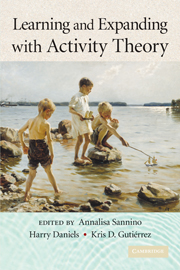Book contents
- Frontmatter
- Contents
- Contributors
- Editors' introduction
- 1 Activity Theory Between Historical Engagement and Future-Making Practice
- PART ONE UNITS OF ANALYSIS
- 2 Cultural-Historical Activity Theory and Organization Studies
- 3 Uses of Activity Theory in Written Communication Research
- 4 On the Inclusion of Emotions, Identity, and Ethico-Moral Dimensions of Actions
- PART TWO MEDIATION AND DISCOURSE
- PART THREE EXPANSIVE LEARNING AND DEVELOPMENT
- PART FOUR SUBJECTIVITY, AGENCY, AND COMMUNITY
- PART FIVE INTERVENTIONS
- Bibliography
- Author Index
- Subject Index
3 - Uses of Activity Theory in Written Communication Research
Published online by Cambridge University Press: 05 June 2012
- Frontmatter
- Contents
- Contributors
- Editors' introduction
- 1 Activity Theory Between Historical Engagement and Future-Making Practice
- PART ONE UNITS OF ANALYSIS
- 2 Cultural-Historical Activity Theory and Organization Studies
- 3 Uses of Activity Theory in Written Communication Research
- 4 On the Inclusion of Emotions, Identity, and Ethico-Moral Dimensions of Actions
- PART TWO MEDIATION AND DISCOURSE
- PART THREE EXPANSIVE LEARNING AND DEVELOPMENT
- PART FOUR SUBJECTIVITY, AGENCY, AND COMMUNITY
- PART FIVE INTERVENTIONS
- Bibliography
- Author Index
- Subject Index
Summary
Documents largely organize the activity of the modern world and – a forteriori – the postmodern world, with its reliance on hypertextual networks. Writing is arguably the most powerful mediational means for organizations and institutions, and writing-in-use in organizations has become an object of research in the past 25 years in North America, with applications in a number of fields, primarily organizational (business, technical, and scientific) communication and education (Bazerman & Russell, 2003). In these fields, analysis of writing-in-use is often crucial for planning interventions to improve students' literacy, at all levels, or to improve organizations' communication, through document design and document management, or what has come to be called information design and information management.
This tradition is largely separate from literary or, indeed, applied linguistic research, though both have influenced it (Bazerman, 1997; Russell, 1997b). Instead, it grows out of a U.S. tradition of rhetorical analysis applied to texts, particularly the concept of genre as social action (Miller, 1984, 1994), with deep roots in Schutz's phenomenological analysis of typification (Schutz & Luckmann, 1973). I will refer to it as writing, activity, and genre research (WAGR). Sociological studies of science and technology were the original impetus (Latour & Woolgar, 1979; Merton, 1968), along with studies of orality and literacy, particularly studies based on Vygotsky's theory (most importantly, Scribner & Cole, 1981).
Empirical and historical research on written communication in this tradition has from its inception in the early 1980s found cultural-historical activity theory (CHAT) useful.
- Type
- Chapter
- Information
- Learning and Expanding with Activity Theory , pp. 40 - 52Publisher: Cambridge University PressPrint publication year: 2009
- 32
- Cited by



